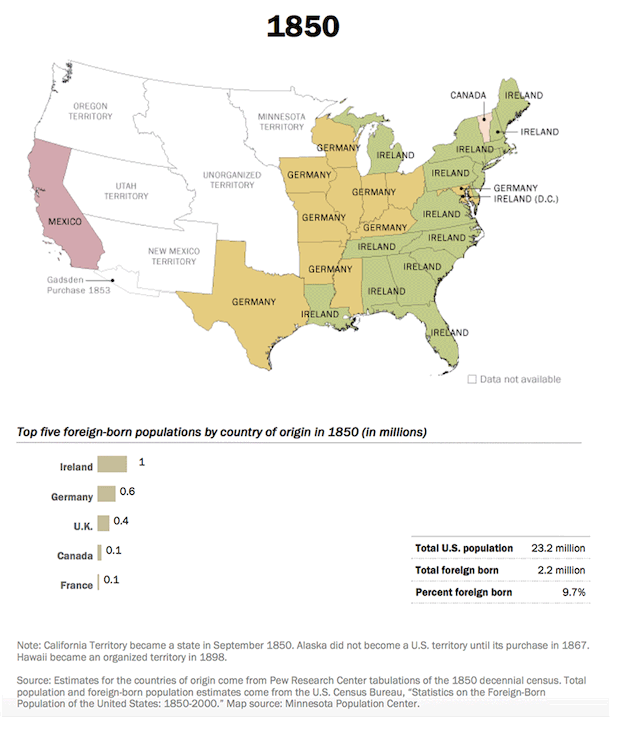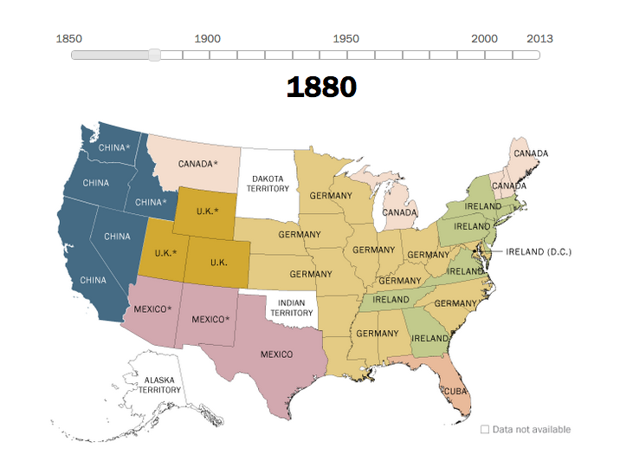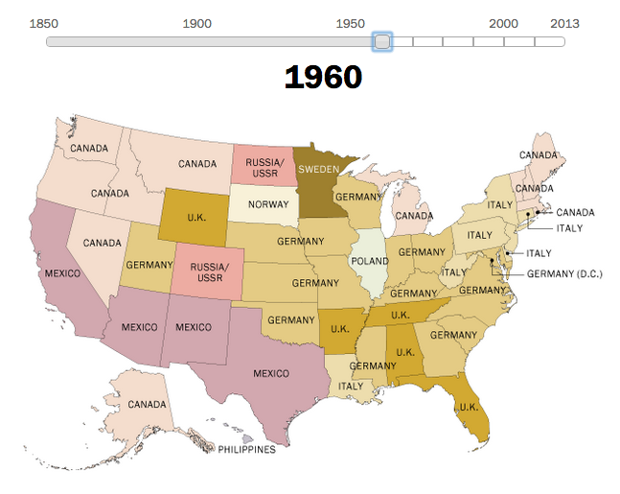A State-by-State Map of Where U.S. Immigrants Came From
A State-by-State Map of Where Immigrants Came From
The new Pew interactive covers 1850 to 2013.

Pew Research Center
U.S. migration patterns changed plenty from 1850 to 2013. A nifty interactive map, created by the Pew Research Center, visualizes these shifts by showing the origin of the dominant immigrant group in each state for every decade during this time period.
The map is a part of a comprehensive report on past and future immigrationtrends, the main point of which is to highlight the impact of the Immigration Act of 1965. But the map reveals the events, policies, and trends before and after 1965 that shaped the waves of U.S. immigration.
From 1850 to 1880, for example, Irish immigrants were the largest group of new arrivals, closely followed by Germans. The Irish potato famine and crop failuresin Germany, and later war and political destabilization in Europe, are all partly responsible for pushing out these and other migrants out of Europe and into America—well into the 20th century.
While these European migrants faced discrimination and xenophobia, their numbers weren’t restricted by immigration policy the way Chinese and Hispanic immigrants were (at least not in the 19th century). Workers from China and Mexico were a substantial presence in Western and Southern states, respectively, in 1880 (below). The Chinese Exclusion Act of 1882 clamped down on workers from China because they were believed to be stealing economic opportunities and were considered racially inferior.

More restrictions were put in place in 1924 so that by 1960, the biggest immigrant populations in most U.S. states were white, Pew’s map shows:

It’s only after the 1965 Immigration and Nationality Act that the U.S. starts to diversify again, in large part due to a massive influx of immigrants from Mexico and Latin America. But in recent years, Asian immigrants have overtaken those Hispanic origins in number. Pew now projects that Asians will become the largest immigrant group in the country in the next 50 years. In 2065, the share of Asians in the U.S. population is likely to be almost double that of white immigrants.
A State-by-State Map of Where Immigrants Came From
The new Pew interactive covers 1850 to 2013.
- TANVI MISRA
- @Tanvim
- Oct 1, 2015
- Comments

Pew Research Center
U.S. migration patterns changed plenty from 1850 to 2013. A nifty interactive map, created by the Pew Research Center, visualizes these shifts by showing the origin of the dominant immigrant group in each state for every decade during this time period.
The map is a part of a comprehensive report on past and future immigrationtrends, the main point of which is to highlight the impact of the Immigration Act of 1965. But the map reveals the events, policies, and trends before and after 1965 that shaped the waves of U.S. immigration.
From 1850 to 1880, for example, Irish immigrants were the largest group of new arrivals, closely followed by Germans. The Irish potato famine and crop failuresin Germany, and later war and political destabilization in Europe, are all partly responsible for pushing out these and other migrants out of Europe and into America—well into the 20th century.
While these European migrants faced discrimination and xenophobia, their numbers weren’t restricted by immigration policy the way Chinese and Hispanic immigrants were (at least not in the 19th century). Workers from China and Mexico were a substantial presence in Western and Southern states, respectively, in 1880 (below). The Chinese Exclusion Act of 1882 clamped down on workers from China because they were believed to be stealing economic opportunities and were considered racially inferior.

More restrictions were put in place in 1924 so that by 1960, the biggest immigrant populations in most U.S. states were white, Pew’s map shows:

It’s only after the 1965 Immigration and Nationality Act that the U.S. starts to diversify again, in large part due to a massive influx of immigrants from Mexico and Latin America. But in recent years, Asian immigrants have overtaken those Hispanic origins in number. Pew now projects that Asians will become the largest immigrant group in the country in the next 50 years. In 2065, the share of Asians in the U.S. population is likely to be almost double that of white immigrants.